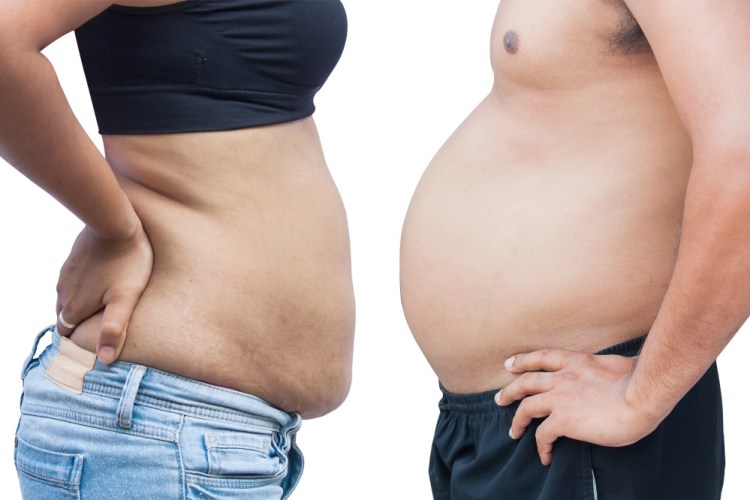Where there’s fat, oh, how we want flat. We try everything from fad diets to pointless pills. Here’s what really works.
It’s a pretty universal desire. I’m not talking about the living-forever wish – I mean having a flat belly. Have you ever heard anyone say, “No, actually, I’d like to go with the round, protruding kind.”
No, didn’t think so.
But how do we get there?
Claims are everywhere. If you believe what you see online, there are exercises that give you six-pack abs in 30 days, tart-cherry-based diets that eliminate flab in a jiffy or, a personal favorite, “belly-fat-fighting pills.”
“There are an infinite set of claims out there spread by the fitness, diet and supplement industry,” says Scott Kahan, a doctor and the director of the National Center for Weight and Wellness in Washington.
“The claims are overinflated or just plain wrong,” he says. “We all want that silver bullet, but it just doesn’t exist.”
So, as much as you don’t want to hear it, fighting belly fat is neither fast nor easy. You have to go back to the basics: Make general health and fitness part of your everyday life.
“Exercise, nutrition, sleep and reducing stress are all important factors in reducing belly fat in particular and improving general health,” Kahan says. “I can’t prioritize them, but small changes in one or several of the categories can make a big difference.”
• • •
Let’s consider the two types of belly fat we see (and most of us have).
There is subcutaneous fat – the love-handle kind. It’s unsightly but not metabolically active. In other words, it sits there without creating too much havoc in our bodies, says Cassia Denton, a personal trainer and group fitness director at Balance Gym in the District.
But then there is visceral belly fat – the fat that surrounds your organs. This is potentially dangerous.
“These visceral fat cells actually pump out hormones into your body. They’re like an endocrine organ,” Denton says. “They can directly affect your LDL levels adversely.” (LDL is the “bad” cholesterol.) These fat cells and the hormones they create can also increase your risk for heart disease and diabetes, she says. Finally, they increase inflammation in the body, which taxes the immune system.
How do you know if you have this potentially dangerous type of fat?
One indication is your waist circumference. Anything more than 40 inches for men and 35 inches for women may raise a red flag to your doctor and inspire further investigation.
Also, where fat is deposited – having an apple-shaped body (as opposed to a pear-shaped body) is an indication that there may be a concern regarding visceral fat. That depends on factors including genetics, hormones and stress level, Kahan says.
• • •
Now let’s see what we can do to beat the bulge.
At the exercise end of things, Kahan recommends the government guidelines of 150 minutes of cardio a week and a couple of resistance training “bouts,” as he puts it.
Denton says she would like to see more emphasis on resistance training because it helps create more lean muscle mass, which helps raise your overall metabolism. Moderate aerobic work, such as running, also has a place. Resistance training can’t be done every day because the body needs a couple of days to recover, while steady-state aerobic work can be done more often, even daily.
So if you want to work out every day, try alternating cardio and resistance, she says.
Resistance training not only improves the resting metabolic rate, but it also appears to improve the health of the actual muscle cells, Kahan says.
And finally, will it help our belly shape if we do a thousand crunches a day?
“You can tone, but you can’t spot-reduce,” Kahan says.
When it comes to nutrition, there are several key points, says Rebecca Mohning, a Washington-area registered dietitian and owner of the Expert Nutrition website (expertnutrition.net).
“Hydration and increasing fiber in the diet are important,” Mohning says.
Complex carbohydrates, such as whole grains, beans and vegetables, are also key in creating a healthful diet that reduces belly fat.
But, Mohning says, if you haven’t been eating cruciferous veggies, such as broccoli, introduce them gradually, or you might experience bloating – which is sometimes confused with belly fat.
“Carbonation and gum can also make you feel bloated,” she says. Bloating might be reduced by probiotics, added to the diet through foods such as kefir or through supplements.
She recommends eating slowly and reducing sugar, which we now know causes inflammation and metabolic disorder in the body.
Eating enough protein as we age is also important. As we hit middle age, as much as 25 to 30 grams of protein per meal can be helpful, she says.
• • •
Surprisingly, though, as a nutritionist who works with a lot of athletes, Mohning considers neither nutrition nor exercise to be the prime weapons in the fight against a tubby tummy. Instead, she points to sleep and stress.
“I would say No. 1 is sleep, No. 2 is stress, followed by nutrition and then exercise,” she says. “If you’re exhausted, it’s better to sleep the extra 30 to 40 minutes than to exercise.”
Why is this?
Because while we can’t affect our genetics in terms of where we deposit fat, we can affect our levels of cortisol, the stress hormone, which has been shown to specifically increase belly fat.
Not only does cortisol affect where we deposit fat, but it also encourages us to eat more sugar and make other unhealthy food choices as we deal with the cortisol-induced flight-or-fight rush of anxiety coursing through the body.
Yoga, meditation and good sleep (no caffeine or alcohol before bedtime, and keep the bedroom cool, dark, quiet and screen-free, suggests Mohning) are all crucial.
In short: “Stress management is part of weight management,” she says.
Send questions/comments to the editors.


